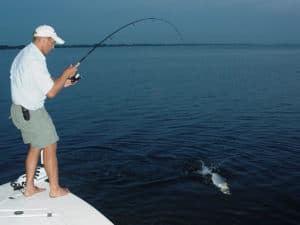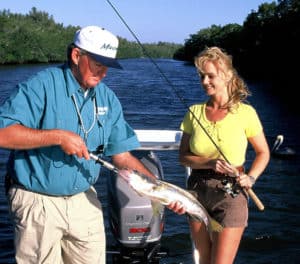By Bob McNally
Fishing Florida with light-tackle fishing for a wide variety of marine species, including glamour species like tarpon and snook, is available 12 months per year in the South Florida haven known as the 10,000 Islands.

Tarpon can be found even in winter, and some big fish can be caught, though most are “baby” tarpon weighing up to about 40 pounds.
If there still is an “old Florida” that remains—a parcel spared the developer’s bulldozer and dredge—it surely must be South Florida’s 10,000 Islands.
This is an island fishing kingdom, a place you don’t drive to by chance, because there’s not much else around except fish and fishermen. There’s a great reason fishing Florida attracts anglers from across the globe, and this wild 10,000 Islands region of South Florida should be near the top of the fishing Florida bucket list.
This is gator, panther and bald eagle country, and it characterized by impenetrable mangrove swamps. This is a place where mosquitoes are the most abundant bird of prey. It’s a place so wild and remote that road signs don’t designate deer crossings, but warn of black bears and Florida panthers sharing the highway.
Chokoloskee is a famous Florida fishing village, smack in the middle of the fabled 10,000 Islands, at the north edge of Everglades National Park. It’s a place steeped in rich light-tackle fishing tradition. But the bulk of the attention the place receives is in winter and early spring is primarily from snook addicts.
While snook fishing is superb in the 10,000 Islands out of Chokoloskee, and winter and spring are choice times for them, the area has much more to offer anglers, with outstanding angling available every day of the calendar.

Snook are among the most prized target for anglers fishing Florida in the 10,000 Islands, with great fishing winter through spring.
Fishing Florida at 10,000 Islands from January through March is a slam dunk because the weather is comfortable, and the insects around mangroves are not bad. This is peak time for grass flats seatrout, which range from 1 to 3 pounds. Plus, 2- to 4-pound Spanish mackerel are seemingly everywhere “outside” of the mangrove swamps in the open Gulf of Mexico.
Lots of snook are available in the “back-country” maze of mangroves, as well as some snook near outside mangrove islands and river mouths.
April through June is the most prime period for back-country snook action. Lots of fish are available, and some big spawning females are around. The rivers hold some giant linesiders, which must be released, but there are 30 to 35 pound fish in June.
Guide Terry Shaughnessy once caught a 51 1/2-incher, weighing 37 pounds—a female that had already spawned. That giant snook was caught in June. On another legendary June trip, in two days of snook fishing another with clients, a guide boat caught 52 snook. Capt. Danny Mitchell produced 32 snook one day, and 28 fish the next day for his guided crew. The fish were caught on lures and live baits, weighing from 8 to 22 pounds.
Big “sleeping” tarpon (100 to 150 pounders) can be found in small pods in early winter mornings in back bays at Chokoloskee. Tarpon in the 50- to 100-pound range also are in great supply in June. Early in the mornings, tarpon roll at river mouths like the Houston, Turner and Chadham. During falling tides, they readily hit jigs, topwater plugs, streamer flies and live crabs.
Permit fishing has never been better in Florida than what’s available on the wrecks off Chokoloskee from March through June. Shaughnessy often begins a day of fishing working wrecks, then when the sun rises and the wind blows, he runs back inshore for snook, tarpon, redfish and other species.
Redfish are in good supply wherever there’s shell, and shell beds are easy to find at low tide. Sheepshead to 6 pounds also like the shell. Turtle, Joe Kemp and Rock Hole keys are hot spots for 4- to 10-pounders. Anglers running boats from fishing spot to spot should check boat wakes for “skipping” pompano, which apparently love to surf the waves. Spot a pompano, circle back, and cast the area with 1/4-ounce white or yellow nylon jigs, and 1- to 4-pound pompano are often the result.
Tripletail action is outstanding during January, February and March. They average 4 to 6 pounds and can be found holding under crab trap buoys, which are available by the hundreds. A soft-plastic D.O.A. Shrimp in natural or root beer color is rarely refused by tripletail. Dozen-fish days are not unusual, and some tripletail weighing double digits are caught by anglers fishing Florida in the 10,000 Islands region.
Cobia weighing 20 to 30 pounds are on the flats during the first three months of the year, feeding behind sting rays. Bigger cobia and grouper can be found on nearshore wrecks, some as close as 3 miles offshore. Such wrecks are found in 18 to 25 feet of water and are safe for even flats skiffs to reach, particularly in early mornings on a calm, sunny, warm, South Florida Gulf of Mexico day.
The chief place for visiting 10,000 Islands anglers to headquarter is Chokoloskee. The towns of Marco and Goodland on Marco Island are popular, too, but they are more upscale and expensive than Chokoloskee.
Guides Terry Shaughnessy, who can be reached at (239) 695-0687, and Danny Mitchell, who can be emailed at [email protected], know the Chokoloskee area and can lead anglers to fish-filled days.
The Union Sportsmen’s Alliance website is designed to provide valuable articles about hunting, fishing and conservation for members of AFL-CIO affiliated labor unions and all sportsmen and sportswomen who appreciate hunting and fishing and want to preserve our outdoor heritage for future generations. If you would like your own story and experience from the outdoors to be considered for our website, please email us at [email protected].








